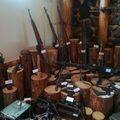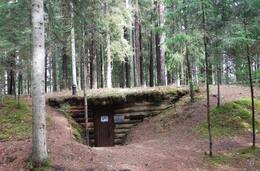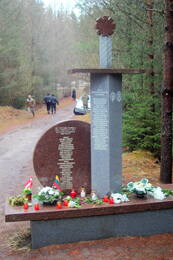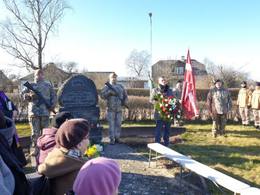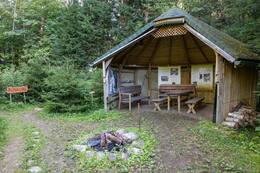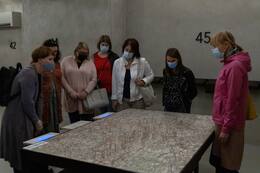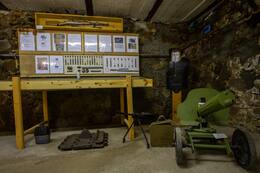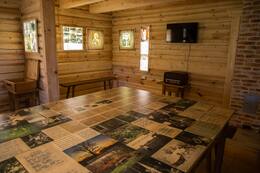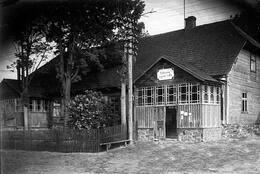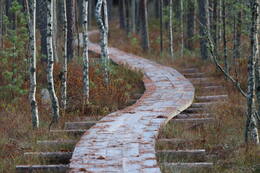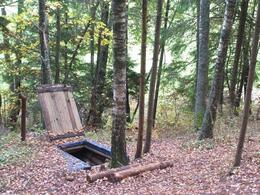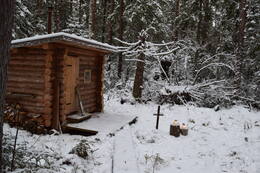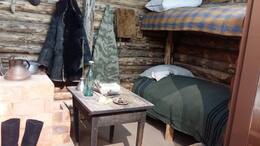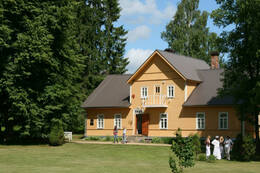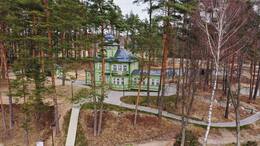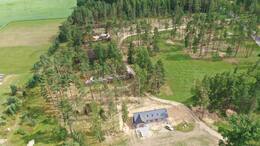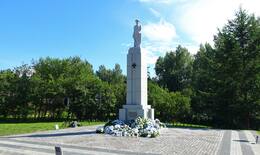Miško brolių pėdomis Latvijoje ir Estijoje
Petro Čeverso nacionalinių partizanų bunkeris
Petro Čevero nacionalinių partizanų bunkeris yra Laucienės savivaldybėje, apie 4 km nuo Talsų–Upesgryvos kelio. Į jį veda medžio drožlėmis grįstas takas. Atnaujintas 31 kvadratinio metro ploto bunkeris pastatytas iš betoninio karkaso, apdailintas pusrąsčiais, kad būtų sukurtas autentiškas vaizdas.
Kapitono Čeverio grupė bunkerį miške netoli Vangzenės baigė statyti 1949 m. spalio pabaigoje. Buvo planuojama išgyventi 1949–1950 m. žiemą. 1950 m. vasario 3 d. vietos miškininkas išdavė partizanus, ir bunkerį užpuolė daugiau nei 300 kareivių Čekos dalinys. Tuo metu bunkeryje buvo 19 žmonių – 17 vyrų ir dvi moterys. Šioje nelygioje kovoje žuvo šeši partizanai, tačiau kitiems pavyko pralaužti dvi Čekos apsiausties grandines, kovojant. Žiemos pabaigoje partizanai su savo rėmėjais slėpėsi aplinkiniuose namuose, tačiau pavasarį grupė vėl susivienijo, kol 1950 m. lapkritį buvo užimtas ir sunaikintas. Po Čekos kariuomenės puolimo bunkeris buvo susprogdintas, ir prieš jį atstatant liko tik vandens pripildyta duobė.
Rendos nacionalinio pasipriešinimo judėjimo muziejus
Muziejus yra įsikūręs už kelių kilometrų nuo Rendos parapijos centro. Parodoje pasakojama apie 50 metų trukusį pasipriešinimo judėjimą Latvijoje: pasipriešinimą pirmajai sovietų okupacijai, pasipriešinimą nacistinės Vokietijos okupacijai ir ginkluotą bei nesmurtinį pasipriešinimą sovietų okupacijai. Paroda įsikūrusi dviejuose pastatuose. Pirmajame pastate saugomi pirmosios sovietų ir vokiečių okupacijos įrodymai. Parodoje eksponuojamas restauruotas tvarto pastatas, kuriame dėmesys sutelktas į Nacionalinį partizaninį karą. Tarp dviejų pastatų yra autentiško išplanavimo bunkeris ir kareivių naudoti apkasai. Netoli muziejaus Rendoje esantys kasinėjimai, blindažo aikštelė ir kliūčių ruožas tarnauja kaip jaunimo sargybinių ir visų susidomėjusiųjų treniruočių aikštelė. Apsilankymus būtina užsisakyti iš anksto.
Vienas didžiausių nacionalinių partizanų mūšių, vadinamas Āpūzniekų mūšiu, įvyko 1946 m. sausį netoli čia. Mūšyje Kabilės nacionalinis partizanų būrys nugalėjo daug didesnes okupacinės valdžios pajėgas. Mūšio vietoje, kurioje yra informaciniai stendai, dabar įrengta poilsio aikštelė.
Rubenio bataliono muziejus
Rubenio bataliono muziejus yra Ugalėje. Jis skirtas R. Rubenio batalionui, kuris 1944 m. tarnavo ir kovojo Kuržemėje vadovaujant generolui J. Kureliui, kurelių veiklai ir nacionaliniam pasipriešinimo judėjimui. Muziejuje yra ekspozicija apie Latvijos Centrinės Tarybos (LKT) ir jos Ventspilio grupės veiklą, taip pat LKT memorandumas su 188 parašais ir signatarų nuotraukomis, įtrauktas į UNESCO programos „Pasaulio atmintis“ Latvijos nacionalinį registrą. LKT buvo bendras Latvijos aukščiausios politinės vadovybės ir pogrindinės vyriausybės, veikusios Latvijos okupacijos metu nuo 1943 iki 1994 m., centras. Jis buvo įkurtas siekiant koordinuoti įvairių Latvijos pasipriešinimo judėjimų veiklą, siekiant atkurti Latvijos nacionalinę nepriklausomybę. Muziejus taip pat siūlo kelionę į bataliono istorijai reikšmingas vietas (gyvenvietę su rekonstruotu bunkeriu Usmos valsčiuje, mūšio laukus Rendos ir Zlėkų valsčiuose ir kt.).
Rubenio bataliono bunkeris ir mūšio laukai
Restauruotas Rubenio bataliono 2-osios kuopos žeminė yra miške prie Ilziki ežero Usmos valsčiuje. Žeminę galima apžiūrėti iš išorės nemokamai bet kuriuo metu. Tačiau ekskursijas žeminės viduje būtina užsisakyti iš anksto.
Leitenanto Roberto Rubenio batalionas buvo generolo Jānio Kurelio suformuoto karinio dalinio dalis ir žinomas dėl to, kad nepasidavė vokiečių kariuomenei ir demonstravo didelį pasipriešinimą. 1944 m. lapkričio 14–gruodžio 9 d. Ugalės, Usmos, Rendos ir Zlėkų valsčiuose vyko įnirtingi mūšiai tarp 16-osios Vokietijos armijos, SD ir SS dalinių, vadovaujamų policijos generolo Friedricho Jeckelio, ir Kureliečių dalinio bataliono, vadovaujamo leitenanto Roberto Rubenio. Rubenio vadovaujami vyrai buvo gerai ginkluoti ir organizuoti, nesiejo savęs su jokia iš dviejų priešiškų okupacinių jėgų. Jų veiksmai laikomi plačiausiais ir ilgiausiais Latvijos nacionalinio pasipriešinimo judėjimo istorijoje. Mūšiuose prie Rendos ir Zlėkų žuvo apie 250 vokiečių kareivių, o Rubenio vyrai patyrė tik 50 aukų. Tų dienų įvykius simbolizuoja miške atkurta žeminė (velėna dengta, žemėje iškasta rąstinė trobelė), kurioje kadaise buvo apsistoję Rubenio bataliono vyrai.
Ylės nacionalinių partizanų bunkeris
Bunkeris yra Zebrenės seniūnijoje, Ylės girininkijoje, išsukus iš kelio P104 Bikstai–Aucė.
Ylės nacionalinių partizanų grupė, kuriai vadovavo Karlis Krauja, susikūrė 1947 m. Grupės vadu buvo išrinktas V. Ž. Brizga (slapyvardis K. Krauja). 1948 m. spalį ši grupė susijungė su lietuvių nacionalinių partizanų grupe. Kraujos grupė veikė Jelgavos apskrityje, joje buvo 27 nacionaliniai partizanai. 1948 m. spalį Jelgavos apskrities Lielaucės valsčiuje, netoli Ylės girininkijos, 300 m į šiaurę nuo sodybos „Priedaiši“, Kraujos grupė įsirengė požeminį bunkerį. Jo bendras ilgis, įskaitant slaptus priėjimus, buvo 45 metrai. Aplink bunkerį buvo išdėliota 70 nuotoliniu būdu valdomų minų. Bunkeryje buvo įrengta krosnis, šulinys, tualetas ir sandėlis.
1949 m. kovo 17 d. bunkeryje buvę 24 partizanai stojo į savo paskutinį mūšį su 760 Valstybės saugumo ministerijos (čekistų) karių. Po mūšio 9 partizanai buvo suimti, o 15 žuvo, iš jų – 8 latviai ir 7 lietuviai.
1992 m. krašto apsaugos kariai kartu su Dauguvos vanagais atkūrė susprogdintą bunkerį. Toje vietoje pastatytas Baltasis kryžius, paminklinis akmuo ir granito stela.
Bunkerio viduje yra krosnelė, stalas ir siauri gultai, ant kurių miegojo partizanai. Prie bunkerio yra informacijos stendai, paminkliniai akmenys su partizanų vardais ir pavardėmis.
Zlēku tragedijos memorialinė vieta
Memorialas yra netoli Zlėkų dvaro ansamblio, vakarinėje Karātavkalno dalyje. Ratą sudaro apie dvidešimt riedulių su žuvusiųjų vardais, o centre – maždaug trijų metrų aukščio juodo marmuro obeliskas.
Kai kurie žuvusieji buvo perlaidoti Zlēkų memoriale.
1944 m. gruodį Zlēkų apylinkėse nacistinė vokiečių armija įvykdė didelio masto operaciją prieš civilius gyventojus. Armijų grupės „Nord“ kovinių veiksmų žurnale 1944 m. gruodžio 9 d. 17.30 val. buvo įrašyta, kad per mūšį priešo pusėje žuvo 161 žmogus, priklausęs „Rubenso brigadai ir Raudonosios strėlės daliniams“. Sovietmečiu šis skaičius, matyt, buvo laikomas bendru Zlēkų tragedijos aukų skaičiumi, kalbant apie žuvusius civilius gyventojus.
Veiksmų eiga iš dalies dokumentuota 1944 m. gruodžio 31 d. Vokietijos 16-osios armijos kontržvalgybos skyriaus vadovo ataskaitoje. Joje aiškinama, kad gruodžio 5–9 dienomis, vadovaujant aukščiausiam SS ir policijos vadovui Ostlande, SS oberruppenfiureriui ir policijos generolui Friedrichui Jekelnui, Eichensumpfe („Ąžuolų pelkėje“) vyko didelio masto operacija prieš „Raudonąsias strėles“ ir generolo Kurelio grupės likučius Abavoje.
Nacionalinių partizanų memorialinė vieta Striķu gatvėje, Saldus
Memorialas yra Striķu ir Lauku gatvių sankryžoje.
Tragiškai kruvinas įvykis šioje vietoje įvyko taikos metu 1950 m. vasario 24 d. Salduse, Strikių (tuometinės 5. augusto) gatvėje, netoli 33-iojo ir 35-ojo namų. Šios gatvės 33-iajame name, po Žiemgalos miško brigadų grupės su jos štabo bunkeriu Ylės miškuose sunaikinimo 1949 m. kovo mėn., gyvi ir nesugauti trys miško brigados, tarp jų pats grupės vadas Kārlis Krauja (tikrasis vardas Visvaldis Brizga) ir jo bendrininkas Vilis Krusts. Jie tikėjosi praleisti 1950 m. žiemą Bergmanių namuose Salduse, tačiau buvo suimti ir susekė. Abu namus apgulė apie 30 čekistų, o anksti ryte įvyko įnirtingos kovos. Čekistai buvo apšaudyti iš abiejų namų, tačiau pralaimėję triuškinančiai persvarai, abu partizanai bandė pabėgti į netoliese esantį Veidės mišką. Tačiau čekistai partizaną Krustą nušovė jau ant namo laiptų, o Kraują – apie 80 metrų toliau miško link.
Abu namai buvo padegti, gyventojų iš anksto paprašius išeiti ir pažadėjus, kad jų gyvybės bus išsaugotos. Yra pranešimų, kad žmonės išėjo, bet vis tiek buvo sušaudyti vietoje. Tarp sušaudytųjų arba dūmuose uždususių žmonių buvo tėvas ir sūnus Kursinskiai iš 35-ojo namo, kurie rėmė partizanus, bet taip pat buvo sušaudyta Kursinskių namo gyventoja Leontine Ezerkalni, kuri nežinojo apie savo šeimininko ryšius su miško brigadomis.
Nacionalinių partizanų bunkeris – Miško broliai
Miško brolių bunkeris yra prie Rygos–Pskovo (A2) greitkelio, 76 kilometrus nuo Rygos ir 11 kilometrų nuo Cėsių. Latvijos nacionaliniai partizanai arba miško broliai buvo nedidelės, ginkluotos vietos gyventojų grupuotės, kurios nuo 1944 iki 1956 metų Latvijos teritorijoje kovojo savarankiškai prieš SSRS okupacinį režimą. Miškuose buvo priversti slėptis žmonės, kurie negalėjo arba nenorėjo gyventi Sovietų Sąjungoje. Iš viso Latvijoje veikė apie 20 193 miško broliai. Bunkeris buvo suformuotas remiantis buvusių miško brolių pasakojimais ir prisiminimais apie gyvenimą miškuose, slapstymąsi ir kovą už nepriklausomą Latvijos valstybę po 1945 metų. Bunkeryje eksponuojami ginkluotė ir namų apyvokos daiktai. Eksponuojami partizanų asmeniniai daiktai, ginklai ir nuotraukos. Gido pasakojimą papildo vaizdo įrašas iš interviu su miško broliais. Prie bunkerio yra vieta piknikui. Galima iš anksto užsisakyti ant laužo paruoštos sriubos arba mėgautis vakaru po atviru dangumi žiūrimu kino teatru prie laužo.
Istorinė ekspozicija „Deganti sąžinė“
Istorinė ekspozicija „Sąžinės ugnis“ yra Cėsyje, netoli Cėsių pilies aikštės. Įkurta sovietmečio laikinojo sulaikymo įstaigoje, ji pasakoja apie Latvijos okupaciją ir atskleidžia stebinančias bei didvyriškas asmenų pasipriešinimo istorijas. Kieme yra memorialinė siena su 643 buvusio Cėsių rajono gyventojų, žuvusių per sovietų represijas, vardais, įskaitant 1941 ir 1949 m. deportuotus nacionalinius partizanus bei sušaudytus ir mirties bausme nuteistus asmenis. Parodos laiko juosta skatina lankytojus susipažinti su Latvijos okupacijos eiga nuo 1939 iki 1957 m. Pagal temas išdėstytos citatos iš vietinių laikraščių siūlo palyginti dviejų okupacinių režimų politinę propagandą. Šešios laikinojo sulaikymo kameros išliko iki šių dienų originalia forma nuo 1940 iki 1941 m. ir pokario metais. Čia Cėsių rajono gyventojai, sulaikyti už įvairią antisovietinę veiklą, įskaitant nacionalinius partizanus, jų rėmėjus, antisovietinius lankstinukus platinusį jaunimą ir kitus „tėvynės išdavikus“, pirminio tyrimo ir tardymo metu buvo laikomi kelias dienas, o vėliau išsiųsti į pagrindinį KGB pastatą Rygoje. Viskas čia tikra: kameros su geležinėmis durimis, įmontuotos „kormuškos“ (mažos angos maistui), medinės lovos, tualetas sulaikytiesiems, maža virtuvėlė su orkaite, taip pat tipiški sovietmečio aliejiniai dažai ant sienų. 2019 m. paroda užėmė trečiąją vietą nacionaliniame dizaino konkurse – Latvijos metų dizaino apdovanojime.
Nacionalinių partizanų atminimo vieta Sērmūkšyje
Sērmūkšuose yra vienas iš daugiau nei šimto partizanų kovų memorialų Latvijoje. Latvijoje yra daugiau nei šeši šimtai partizanų kovų vietų. Remiantis istoriniais įrodymais pastatytas Latvijos nacionalinių partizanų žeminė, kurioje lankytojai gali praleisti naktį beveik autentiškomis sąlygomis su medinėmis lovomis, apšvietimu žibalinėmis lempomis ir šildymo prietaisu, panašiu į tuos, kuriuos naudojo partizanai. Apsilankymą būtina užsisakyti iš anksto. Lemtinga akimirka Sērmūkšų nacionalinių partizanų grupei atėjo 1946 m. lapkričio 29 d., kai žuvo keturi grupės kovotojai: Janis Zīrāks, Reinholds Pētersons, Janis Pīlands ir Anna Zariņa. Alfrēdsas Suipe išgyveno, atlaikė tremtį, grįžo į Latviją ir sulaukė laisvos valstybės atkūrimo. Jis inicijavo idėją Sērmūkšuose įsteigti memorialinę vietą savo žuvusiems bendražygiams.
Piebalgos kraštotyros ekspozicija Inešyje
Vietovės istorijos ekspozicija įrengta Inešuose esančio Vecpiebalgos dvaro vyno rūsyje. Joje apžvelgiami įvairūs Antrojo pasaulinio karo įvykiai regione. Rūsyje esančioje ekspozicijoje eksponuojami šaudmenys, ginklai, kareivių namų apyvokos daiktai, lėktuvų nuolaužos, ženkleliai ir apdovanojimai, mūšių žemėlapiai ir kiti su karu susiję daiktai. Fronto linija pažymėta unikaliame žemėlapyje, eksponuojamame pirmame aukšte. Žemėlapis yra gerai išsilaikęs, nors daugelį metų praleido pelkėje. Antrame aukšte eksponuojami įdomūs istoriniai įrodymai apie šešių armijų karininką Voldemarą Ozolą (1884–1949). Parodą apie Voldemarą Ozolą gerokai praturtina Mārtiņa Frīdvaldo, iš rusų kalbos išvertusio Manfrēdo Šnepo-Šneppės knygą „Pasaulio šachmatų žaidimai ir Voldemaras Ozolas, šešių armijų karininkas“, papasakota istorija. Knyga yra populiari studija apie generolą Voldemarą Ozolą, prieštaringai vertinamą, bet iškilų Latvijos karinį veikėją. Istorija apie jį apima Pirmąjį pasaulinį karą, Latvijos nepriklausomybės karą ir Antrąjį pasaulinį karą. Mārtiņš Frīdvaldas taip pat pasakoja apie Piebalgos ir dvaro politinę, ekonominę ir kultūrinę istoriją. Ekskursijos trukmė – 1–1,5 valandos. Parodoje taip pat eksponuojami ūkininkų įrankiai ir namų apyvokos daiktai, istorinių įvykių liudininkų pasakojimai ir Ineši teatro istorija. Paroda reguliariai papildoma naujai įsigytais daiktais ir pastaraisiais metais padarytais atradimais, susijusiais su Piebalgos savivaldybės istorija.
Bronislavos Martuževos poezijos klėtelė
Bronislavos Martuževos muziejus įsikūręs poetės vaikystės namų vietoje Indranų valsčiuje, Maduonos savivaldybėje. Muziejaus ekspozicija įrengta renovuotame tvarte, kuriame eksponuojami balso ir vaizdo įrašai iš Nacionalinio pasipriešinimo judėjimo, poetės darbo leidžiant pogrindinį žurnalą, taip pat kuriant eilėraščius ir dainas nacionaliniams partizanams. Bronislava Martuževa dalyvavo pasipriešinimo judėjime nuo pat jo įkūrimo. Lazdinės, Martuževos namai, kurie neišliko, taip pat buvo prieglobstis Latvijos nacionalinių partizanų asociacijos vadovui Pēteriui Supei ir jo bendražygiams. Poetė penkerius metus slapstėsi savo namų rūsyje, susitikinėjo su partizanais, rašė eilėraščius (įskaitant kūrinius, skirtus partizanams Pēteriui Supei, Viliui Tomui, Smilgos grupei, Laiveniekui, Salnui, Celmiņui, Bruno Dundurui ir kitiems), taip pat rašė dainas ir mokė jų partizanus. Dabar jos dainas dainuoja grupė „Baltie lāči“ (pažodžiui: „Baltieji lokiai“). 1950 m. kartu su Viliu Tomu pogrindyje buvo leidžiamas žurnalas „Dzimtene“ (pažodžiui: „Tėvynė“). Poetas ranka perrašė 11 žurnalo numerių, po 10 egzempliorių. Poetė, jos brolis, sesuo, motina ir Vilis Tomas buvo suimti 1951 m. Bronislava Martuževa iš Sibiro grįžo 1956 m. Pripažintas vietos ir šalies mastu, poezijos tvartą lanko tiek vietos gyventojai, tiek savivaldybės svečiai. Susipažinimas su poetės gyvenimu suteikia galimybę atrasti Latvijos likimą.
Lubanos savivaldybės turizmo ir kultūros paveldo centras
Lubanos savivaldybės turizmo ir kultūros paveldo centras yra pačiame Lubanos miesto centre. Jame yra keletas ekspozicijų, įskaitant nuolatines, apie savivaldybės istoriją, kultūrą, tradicijas ir renginius. Nuolatinės ekspozicijos skirtos asmenybėms, kuriomis Lubana ypač didžiuojasi. Jose pristatoma poetė Broņislava Martuževa, Nacionalinio pasipriešinimo judėjimo narė ir politinė kalinė; politikas Hugo Celmiņš, Nepriklausomybės kovų dalyvis; Oskaras Kalpaksas, pirmasis Latvijos armijos vyriausiasis vadas; fotografas Alfredas Grāversas; operos dainininkas Jānis Zābersas; poetas Jānis Gavarsas; menininkas Rūdolfs Pinnis, taip pat folkloristas ir pastorius Mārtiņš Celmiņšas. Gidas pasakoja apie Lačplėšio karo ordino riterių ir laisvės kovotojų gyvenimą Lubanoje ir gretimoje teritorijoje, taip pat apie jų poilsio vietas senosiose Lubanos kapinėse. Galimos kalbos: latvių ir rusų. Ekskursijas su gidu su vertimu į vokiečių ir anglų kalbas galima užsisakyti iš anksto.
Nacionalinių partizanų būstinė gamtos draustinyje „Stompakų pelkės“ (Stompaku purvi)
Antrojo pasaulinio karo metais Stompakų pelkėje buvo viena didžiausių nacionalinių partizanų būstinių Baltijos šalyse. Šiandien ši teritorija priklauso Stompakų gamtos draustiniui. Pelkių salose esančią gyvenvietę galima pasiekti pažymėtu pėsčiųjų taku.
1945 m. pradžioje Stompakų pelkėje buvusioje nacionalinių partizanų būstinėje gyveno 350–360 žmonių, iš jų – 40 50 moterų. Joje buvo 24 gyvenamieji bunkeriai – pusiau į žemę įkasti statiniai, kuriuose galėjo gyventi 3–8 žmonės. Būstinėje taip pat veikė kepykla, požeminė bažnyčia ir trys antžeminės pašiūrės arkliams. Partizanai rengė išpuolius prieš okupacinio režimo pareigūnus.
1945 m. kovo 2–3 d. čia vyko Stompakų mūšis – didžiausias nacionalinių partizanų susirėmimas Latvijoje. Būstinėje buvusius 350–360 partizanų puolė NKVD 143-asis šaulių pulkas ir vietinio stribų (rus. „isterbiteli“) bataliono kovotojai – iš viso 483 vyrai. Mūšis truko visą kovo 2 dieną. Kovo 3-iosios naktį partizanams pavyko ištrūkti iš būstinės ir pasitraukti į ankstesnės bazės vietą. Mūšyje žuvo 28 partizanai, o NKVD neteko 32 karių.
Šiuo metu Stompakų būstinės vietoje yra atkurti trys bunkeriai – bažnyčia, štabas ir gyvenamasis bunkeris, taip pat 21 bunkerio vieta. Įrengti informaciniai stendai apie būstinę ir mūšį. Galima užsisakyti ekskursijas su gidu.
Privati ekspozicija „Abrenės kambariai“ (Abrenes istabas)
Privati ekspozicija „Abrenės kambariai“ įsikūrusi Viliakos mieste, istoriniame pastate. Iš pradžių šis pastatas stovėjo senosios Marienhauzeno turgaus aikštėje. Vėliau čia veikė butai, biurai, įvairios parduotuvės, o Antrojo pasaulinio karo metais – latvių savigynos štabas, gestapas ir čekistų būstinė. Ekspozicijose pristatomi įvairūs Viliakos ir jos apylinkių istorijos laikotarpiai bei įvykiai nuo 1920 iki 1960 metų – kai miestelis priklausė Jaunlatgalės, vėliau Abrenės apskričiai. Tarp eksponatų – Stompakų pelkės partizanų štabo daiktai, pasakojantys apie nacionalinį pasipriešinimą Latgaloje, taip pat dokumentai ir fotografijos iš Nepriklausomybės kovų laikotarpio. Naujausioje ekspozicijoje lankytojai gali susipažinti su kadaise garsia motokroso trasa „Baltasis briedis“
Miško brolių sodyba Verumoje
„Forest Brother“ ūkis yra netoli Latvijos sienos, Vastse-Roosos kaime.
Bunkerio turizmo objektas buvo atidarytas 1999 m., siūlydamas lankytojams galimybę patirti miško brolių gyvenimo būdą kaip Estijos istorijos skyrių. Programa apima miško brolių paiešką slėptuvėje, bunkeryje apsilankymą, susipažinimą su tikrais gyvenimo įvykiais, miško brolių dainų dainavimą su šeimininku ir miško brolių valgio ar puotos ragavimą. Pagrindinis traukos objektas yra bunkeris, išklotas siaurais pušiniais rąstais ir įleistas į kalvos šlaitą. Bunkeryje yra dviaukštės lovos ir nedidelis staliukas. Šio tipo bunkerius XX a. 5-ojo dešimtmečio pabaigoje ir 6-ojo dešimtmečio pradžioje naudojo šimtai drąsių pasipriešinimo vyrų, prislėgtų būtinybės slapstytis nuo valdžios.
Miško brolių muziejaus kambarys Nursi kaimo centre (su memorialu ir netoliese esančio bunkerio kopija)
Įėjimas nemokamas, o muziejaus kambarys dirba bibliotekos darbo valandomis. Bunkeris yra neužimtoje Gynybos pajėgų poligono Nursipalu dalyje. Pratybų metu netoliese girdisi šūviai. Paskutinė kelio atkarpa, vedanti ten, vairuotojams gali būti sudėtingesnė, tačiau didžiąją laiko dalį ji pravažiuojama. Žemė aplink bunkerį gali būti šlapia.
Liukos (Nursi) bunkerio mūšis įvyko 1945 m. gruodžio 28 d. Susirėmime žuvo devyni miško broliai, o antžeminis bunkeris sudegė. Trims vyrams pavyko pabėgti. Mūšio vieta buvo atrasta po daugelį metų trukusių paieškų 2008 m. Po metų prie Veru-Valgos kelio buvo atidengtas mūšio memorialas. Pirmieji kasinėjimai bunkerio vietoje buvo atlikti 2010 m., o tais pačiais metais buvusioje Nursi mokykloje buvo atidarytas mūšiui skirtas muziejaus kambarys. (Miško brolių naudota rašomoji mašinėlė šiuo metu eksponuojama Veru apskrities muziejuje.)
Senosios Veru kultūros centras / Veru muziejus
Šis muziejus yra Veru miesto centre.
Parodoje pristatoma Veru apskrities istorija nuo priešistorinių laikų iki XX amžiaus vidurio.
Taip pat pateikiama Estijos Respublikos gimimo ir Nepriklausomybės karo įvykių apskrityje apžvalga. Be to, muziejus gali pasigirti viena išsamiausių Estijos miško brolių ekspozicijų, įskaitant miško brolių bunkerio vidaus kopiją.
Parodų salėje reguliariai eksponuojamos įvairių temų parodos, taip pat galima lankyti istorijos tematikos muziejaus kursus.
Vastselinos miško brolių memorialas
Šio „Miško brolių“ memorialo planai buvo pradėti kurti 2013 m. pradžioje, kai Vidaus saugumo tarnyba identifikavo masinėje kapavietėje Reedopalo mieste netoli Veru rastus kūnus. Bendradarbiaujant Vastseliinos savivaldybei, Estijos gynybos lygos Veru regioniniam padaliniui ir Gynybos ministerijai, buvo nuspręsta dėl vietos kapinėse ir atlikti reikalingi pasiruošimai. Trylikos „miško brolių“ perlaidojimas įvyko 2013 m. rugsėjo 21 d. Po metų čia buvo atidengtos Mati Karmino sukurtos memorialinės skulptūros, vaizduojančios mažas, iš akmens išskaptuotas egles. 2015 m. lapkričio 1 d. čia buvo perlaidoti dar keturi „miško broliai“, kurių kūnai buvo rasti slaptoje masinėje kapavietėje Reedopalo mieste, ir atidengta daugiau memorialinių eglių, skirtų atminti trijuose skirtinguose mūšiuose žuvusiuosius. Jų tikrieji kapai iki šiol nežinomi.
Satsės sodybos muziejus
Saatse muziejus yra atokiame Pietryčių Estijos kampelyje, netoli Estijos ir Rusijos Federacijos pasienio kontrolės linijos. Nauja nuolatinė Saatse muziejaus ekspozicija „Viskas turi sieną(-as)“ supažindina su pasienio regionų kultūrų raida politinės ir karinės istorijos fone, kad lankytojas būtų įkvėptas toliau mąstyti tema „sienos aplink mus ir mūsų viduje“. Parodoje daugiausia dėmesio skiriama Saatse regiono ypatumams, atsispindint unikalaus Setomaa etninio ir kultūrinio paveldo aspektams.
Verskos lankytojų centras ir Šiaurės stovykla
Restauruoti generolo Nikolajaus Reeko Art Nouveau stiliaus vasarnamiai įsikūrę Verskoje, ant Õrsavo ežero kranto, vaizdingos gamtos apsuptyje.
2020 m. čia atidarytas Verskos lankytojų centras, kuriame pristatomas unikalus regiono paveldas. Parodoje apžvelgiama Petserio šiaurinė stovykla, įkurta čia 1920 m., Nepriklausomybės karo įvykiai ir gydomojo purvo bei mineralinio vandens naudojimas vietos kurortuose.
Šiaurinė stovykla
Šiaurinė stovykla yra įsikūrusi Orsavos ežero pakrantėje į pietus nuo Verskos, Veru apskrityje.
Oficialiai Estijos gynybos pajėgų Petserio šiaurinė stovykla (2-osios divizijos štabo štabas) buvo įkurta XX a. 3-ojo dešimtmečio viduryje kaip vasaros kavalerijos ir artilerijos mokymo centras. Kompleksą sudarė kareivinės, arklidės, karininkų gyvenamosios patalpos, valgykla ir įspūdinga valgykla. Stovykloje taip pat buvo sporto aikštelės ir kortai bei maudymosi įrenginiai prie ežero. Buvo atskiros maudymosi zonos karininkams, kareiviams ir arkliams. Stovyklos viduryje buvo susirinkimų ir paradų aikštės. Artilerijos stovykla buvo kitoje ežero pusėje, įskaitant lentpjūvę.
Dauguma pastatų nuo to laiko buvo sunaikinti, tačiau kareivinės ir kai kurios gyvenamosios patalpos išliko. Vietovę galima apžiūrėti iš išorės.
Paprašius, Verskos ūkio muziejus gali pasiūlyti teminę programą, skirtą Šiaurinei stovyklai.
Pečiorių Laisvės kovų paminklas
Šis paminklas Verskoje buvo pastatytas pagal skulptoriaus Romano Haavamäe 1938 m. projektą ir nuotraukas ir yra unikalus tarp restauruotų Nepriklausomybės karo paminklų Estijoje. Iš pradžių paminklas turėjo būti atidengtas Laisvės parke Petserio mieste, tačiau sovietų okupacija tam du kartus sutrukdė – 1940 ir 1944 m. Jis buvo baigtas po 80 metų ir atidengtas naujoje vietoje Verskoje, naujajame Setomos regiono administraciniame centre. Ant jo puikuojasi Petserio miesto herbas, nes paminklą iš pradžių finansavo miestiečiai. Jis skirtas daugeliui žuvusiųjų – kai kuriais skaičiavimais, Petserio apskrityje vykusiuose mūšiuose žuvo apie 350 žmonių. Paminklas yra penkių metrų aukščio ir jį vainikuoja vyro, laikančio kardą, statula ir skydas su trimis leopardais.





